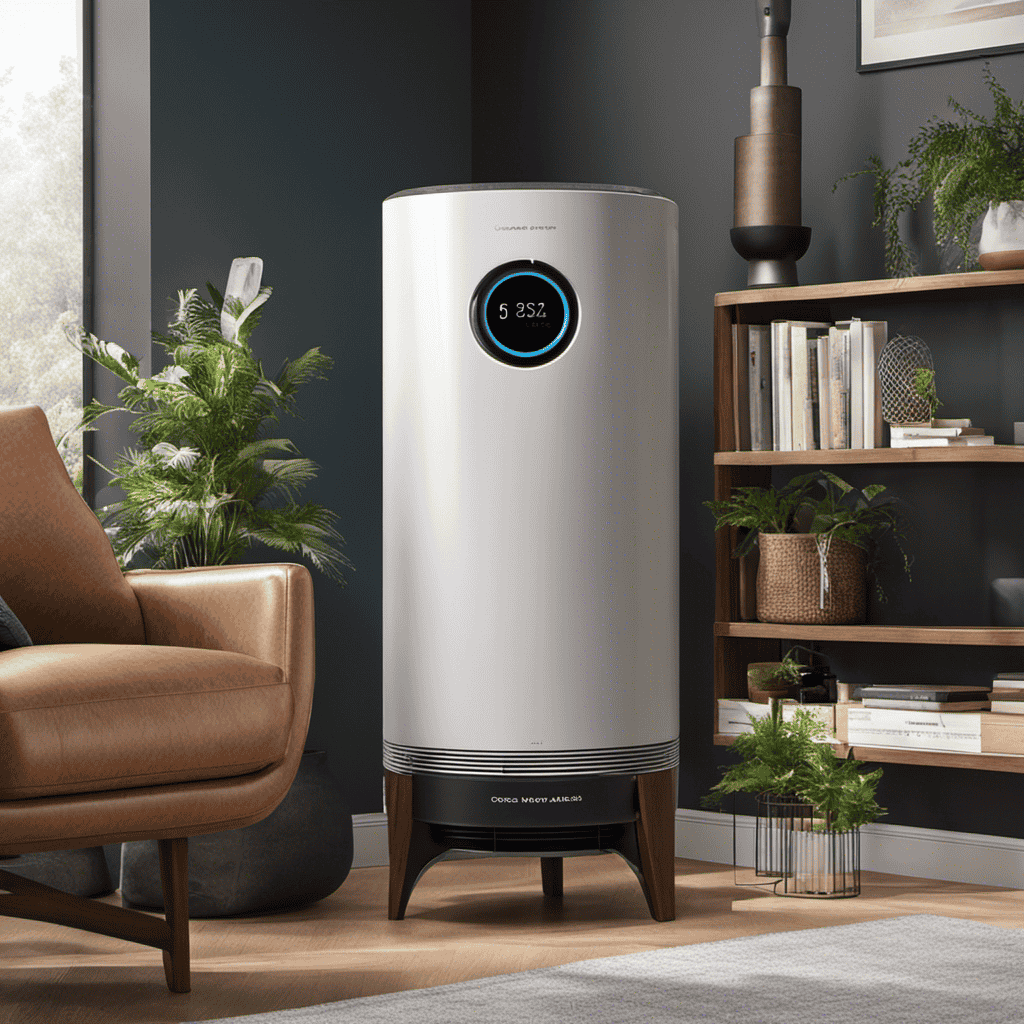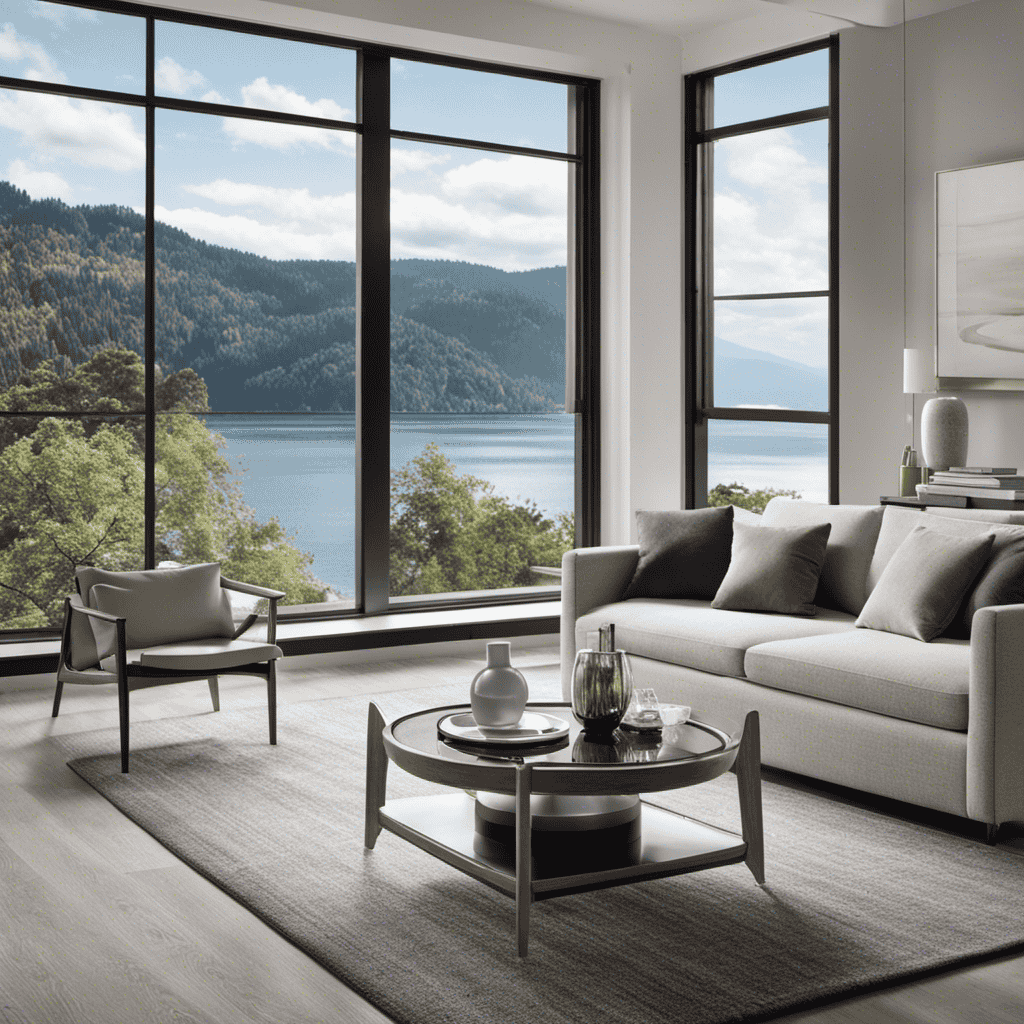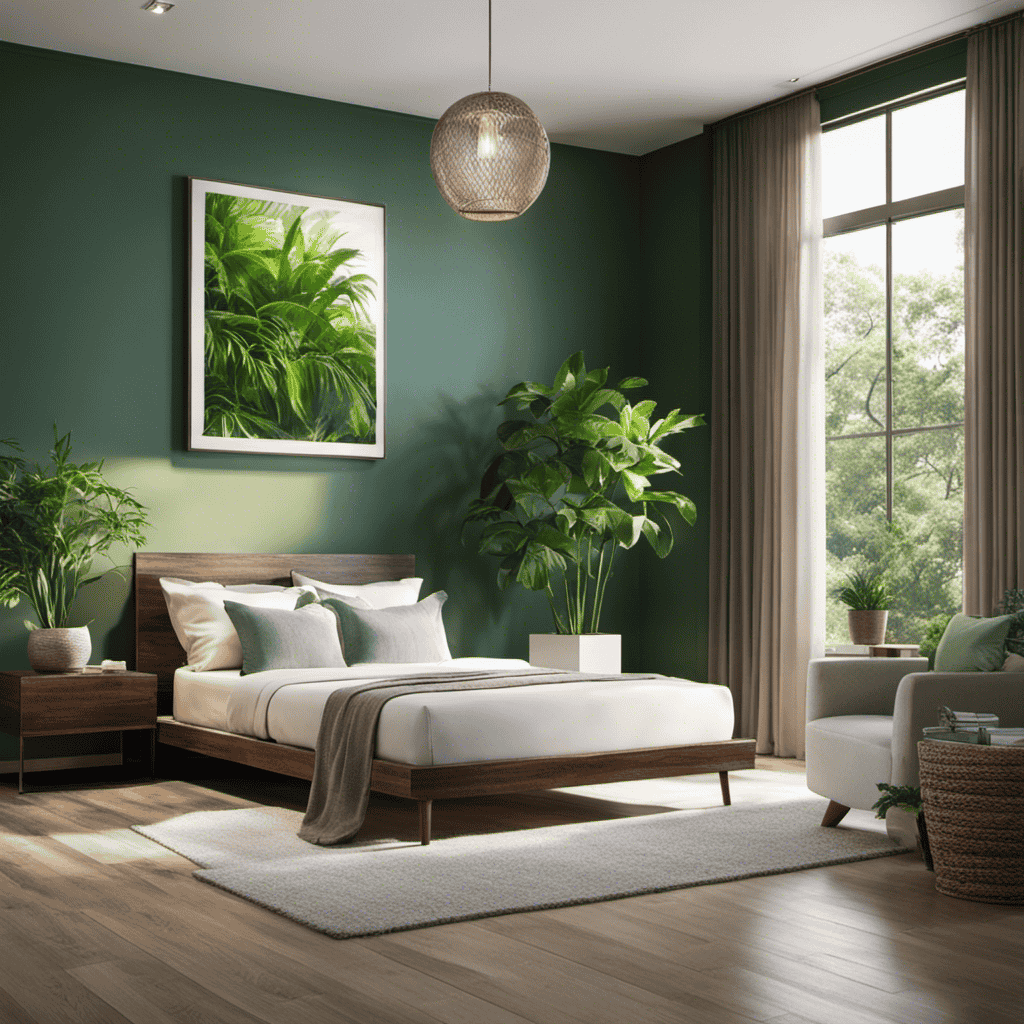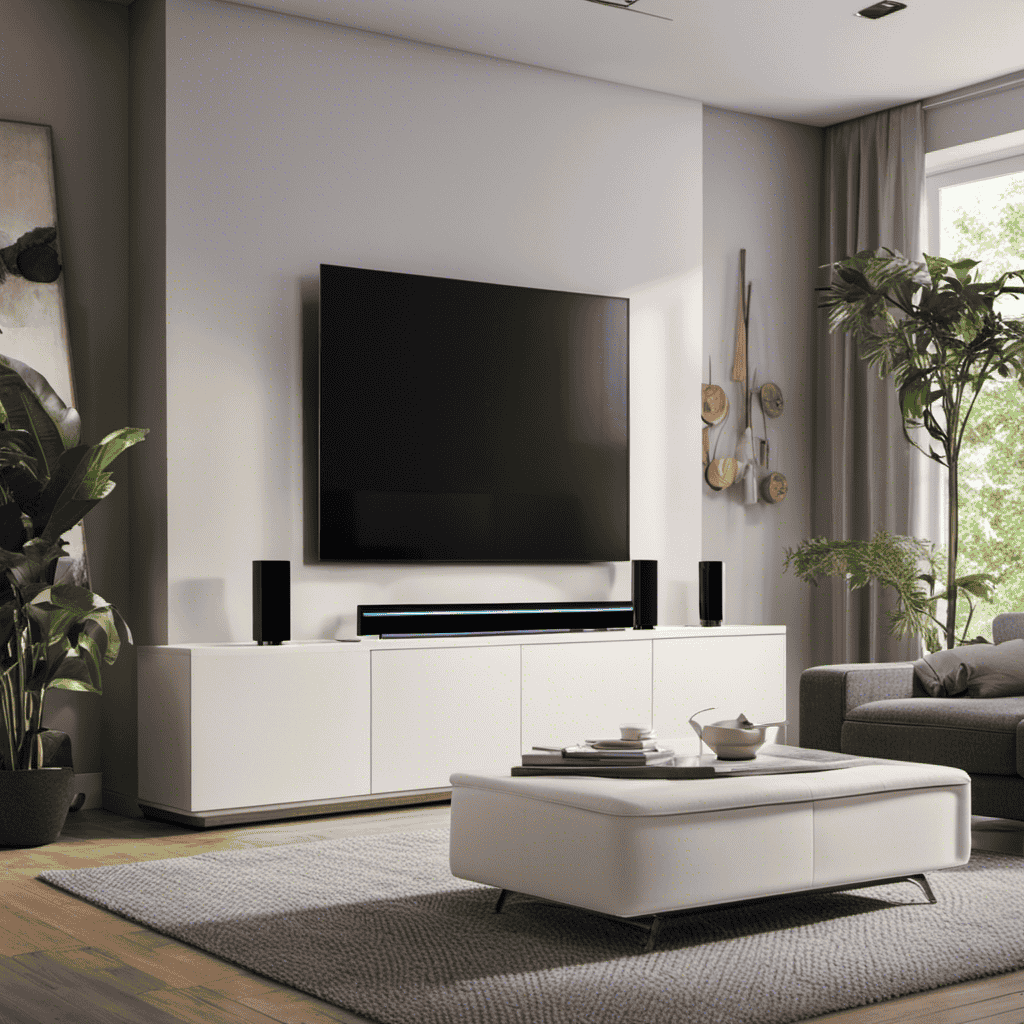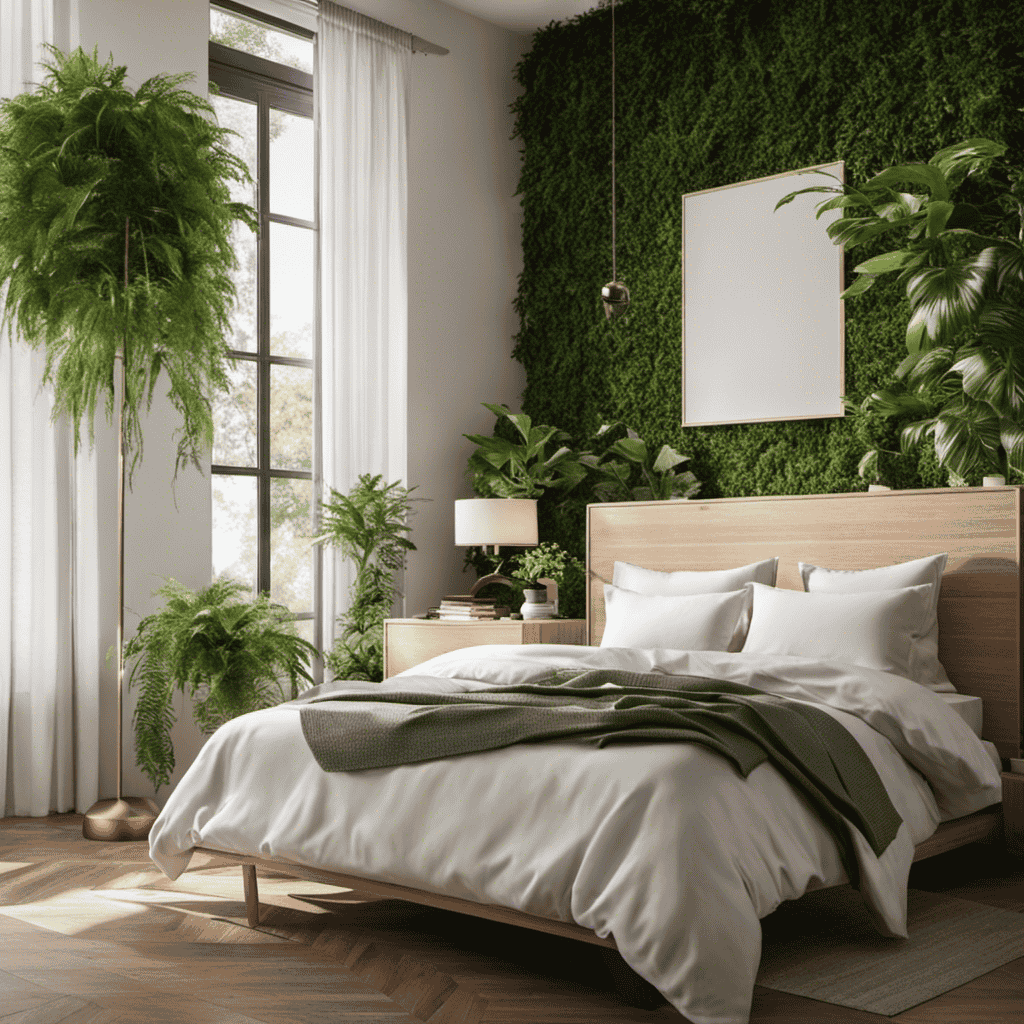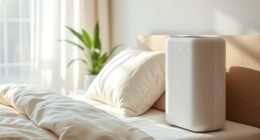As a proud owner of an air purifier, I have carefully considered the best location to place my reliable device. Let me share my discoveries on where to position an air purifier for optimal effectiveness.
Whether you’re snoozing in the bedroom, lounging in the living room, or sweating it out in the gym, strategic placement is key. From allergy hotspots to high traffic areas, I’ll guide you through the best spots to ensure your air is as fresh as a daisy.
Let’s dive in!
Key Takeaways
- Placement in different rooms: Position the air purifier in specific rooms like the bedroom, living room, kitchen, office, and nursery to create a healthier environment by removing pollutants, allergens, and odors.
- Central placement: Placing the air purifier centrally in a room helps capture pollutants from all directions, ensures balanced and thorough filtration, and reduces noise reflections.
- Safe distance from baby: Keep the air purifier at least 6 feet away from the baby’s crib to avoid drafts from air conditioners and to ensure the baby’s safety. Placing the purifier near plants helps remove toxins and pollutants from the air.
- Placement in specific areas: Position the air purifier in areas like the basement, attic, garage, bathroom, and laundry room to improve air quality, reduce pollutants, control moisture, and remove odors specific to those spaces.
In the Bedroom
You should place the air purifier in your bedroom to ensure clean and fresh air while you sleep. This is crucial for safe sleep and for improving the air quality in your room. By positioning the air purifier in your bedroom, you can effectively remove harmful pollutants, allergens, and odors, creating a healthier environment for resting.
Air purifiers work by filtering the air and trapping particles such as dust, pollen, pet dander, and even bacteria and viruses. This helps to reduce the risk of respiratory issues, allergies, and other health problems that can disrupt your sleep. So, for a peaceful and rejuvenating sleep, make sure to have an air purifier in your bedroom.
Now, let’s move on to discussing the placement of an air purifier in the living room.
In the Living Room
Place the air purifier in the living room where it will effectively clean the air. The living room is often a hub of activity, so it’s important to choose the right location for your purifier to maximize its effectiveness.
One key consideration is to place the purifier near windows. This allows it to capture pollutants that may enter the room through open windows or from outside sources.
Additionally, placing the purifier under furniture can help to optimize its performance. Furniture can create barriers that trap dust and allergens, and positioning the purifier underneath can help to capture these particles more efficiently.
In the Kitchen
When it comes to positioning an air purifier in the kitchen, there are a few key points to consider.
First, it’s important to place the air purifier at a safe distance from the stove to avoid any potential fire hazards.
Additionally, positioning the purifier near the food preparation area can help to reduce odors and airborne contaminants.
Safe Distance From Stove
It’s important to maintain a safe distance from the stove when positioning the air purifier. Placing the air purifier too close to the stove can pose potential health risks due to the release of pollutants and gases during cooking. To ensure the air purifier effectively filters out these pollutants, it should be positioned at least a few feet away from the stove. Here is a visual representation of the safe distance guidelines:
| Distance from Stove | Recommended Placement |
|---|---|
| 3-5 feet | Ideal position |
| 1-2 feet | Acceptable |
| Less than 1 foot | Not recommended |
Near Food Preparation Area
To ensure your safety, it is important to keep the air purifier a safe distance away from the food preparation area. Placing it too close can potentially contaminate the food or cause accidents.
Here are the potential benefits of positioning your air purifier near the food preparation area:
-
Improved air quality: An air purifier can help remove airborne allergens, odors, and pollutants, ensuring a cleaner and healthier environment for food preparation.
-
Reduced cooking odors: Cooking can release strong odors that may linger in the kitchen. An air purifier can help eliminate these odors, making your kitchen more pleasant.
However, there are also drawbacks to consider when placing an air purifier near the food preparation area:
-
Noise: Some air purifiers can be noisy, which can be distracting and disruptive during food preparation.
-
Limited space: Placing an air purifier near the food preparation area may take up valuable counter space, making it more difficult to work efficiently.
Considering these factors, it is important to find a balance between the benefits and drawbacks when positioning your air purifier near the food preparation area.
Ventilation and Air Circulation
Make sure you have proper ventilation and air circulation in your kitchen to maintain a fresh and clean environment for food preparation. Ventilation techniques, such as opening windows or using exhaust fans, can help remove cooking odors, moisture, and pollutants from the air.
Proper air circulation is essential to prevent the buildup of stale air and ensure that fresh air is constantly flowing into the space.
Additionally, it is important to regularly maintain your air purifier to ensure optimal performance. This includes cleaning or replacing filters as recommended by the manufacturer and keeping the unit free from dust and debris.
By implementing these ventilation techniques and properly maintaining your air purifier, you can create a healthier and more comfortable kitchen environment.
Now, let’s move on to discussing the importance of proper air circulation in the office.
In the Office
You should place the air purifier in the office where it will be most effective. To ensure optimal air purification, consider the following guidelines:
-
Safe distance from electronics: Keep the air purifier at least three feet away from electronic devices such as computers, printers, and televisions. This will prevent any interference with their functionality and ensure the air purifier works efficiently.
-
Near windows: If possible, position the air purifier near windows. This will allow it to draw in fresh outdoor air, which can help improve indoor air quality. However, be cautious of placing it too close to direct sunlight, as it may affect the air purifier’s performance.
-
Away from obstructions: Ensure that the air purifier is not obstructed by furniture or other objects. This will allow for proper airflow and better distribution of purified air throughout the office space.
-
Central location: Place the air purifier in a central area of the office to maximize its coverage. This will help ensure that the air purifier can effectively clean the air in the entire workspace, providing a healthier environment for everyone.
In the Nursery
When it comes to the nursery, optimal air circulation is crucial for creating a healthy and comfortable environment for your baby.
To achieve this, it’s important to position the air purifier in a strategic location.
Placing it near the crib but at a safe distance from the baby ensures that the air is properly filtered without causing any discomfort or harm.
Optimal Air Circulation
To ensure optimal air circulation, it’s best to place the air purifier in a central location within the room. This allows the purifier to effectively capture and filter the air from all corners of the space.
Here are some reasons why positioning your air purifier centrally can greatly improve its performance and provide you with cleaner, healthier air:
-
Enhanced Airflow: Placing the air purifier in the center of the room allows for better airflow and distribution of purified air throughout the entire space.
-
Maximum Coverage: By positioning the purifier centrally, it can effectively cover a larger area, ensuring that every corner of the room benefits from its air cleaning capabilities.
-
Balanced Filtration: A central placement helps the purifier capture pollutants and allergens from all directions, providing a more balanced and thorough filtration process.
-
Noise Reduction: Placing the purifier away from walls or furniture can help reduce noise reflections, making it quieter and more pleasant to use.
Regular air purifier maintenance and strategic placement can greatly enhance the benefits of air purifiers in the home. So, make sure to position your air purifier centrally to enjoy cleaner, fresher air in every corner of your room.
Safe Distance From Baby
Placing the air cleaning device at a safe distance from your baby is crucial for their well-being. It’s important to consider the potential risks associated with having an air conditioner too close to your little one. While air conditioners are designed to improve indoor air quality, they can also emit cold air and create drafts that may not be suitable for babies.
It is recommended to keep the air conditioner at least 6 feet away from your baby’s crib. Additionally, it’s a good idea to place the air purifier near plants. This is because plants act as natural air filters, helping to remove harmful toxins and pollutants from the air.
In the Basement
It’s best to put the air purifier in the basement to improve air quality. As someone who has researched extensively on air purifiers, I can confidently say that the basement is an ideal location for this device.
Here are four reasons why:
-
Safe Distance from Pets: Placing the air purifier in the basement ensures a safe distance from pets. This is important because some air purifiers emit ozone, which can be harmful to animals when in close proximity.
-
Improved Air Circulation: The basement usually has better air circulation compared to other areas in the house. This allows the air purifier to effectively filter and clean the air, removing pollutants and allergens.
-
Reduced Noise Levels: Air purifiers can sometimes produce noise while running. By placing the device in the basement, the noise levels are reduced, making it more suitable for use in the home office.
-
Contaminant Isolation: Basements often have fewer sources of indoor air pollution. By isolating the air purifier in the basement, it can focus on cleaning the air specifically in that area, leading to better overall air quality in the house.
In the Attic
If you’re considering using the attic as a location for the air purifier, remember to check for proper insulation and ventilation. Attics can be a great spot for an air purifier, as they are often out of the way and provide a centralized location for clean air distribution. However, before installing the purifier, it’s essential to ensure that the attic has adequate ventilation and insulation. Poor ventilation can lead to stagnant air, trapping pollutants and reducing the effectiveness of the purifier. Additionally, a well-insulated attic will help maintain a comfortable temperature and prevent any heat loss or gain, which can impact the overall efficiency of the purifier. By addressing these factors, you can optimize the performance of your air purifier and improve the attic air quality.
| Pros | Cons |
|---|---|
| Centralized location for clean air distribution | Potential for poor ventilation |
| Out of the way and doesn’t take up living space | Requires proper insulation for temperature control |
Overall, with proper ventilation and insulation, the attic can be an excellent location for an air purifier, enhancing the air quality throughout your home.
In the Garage
When it comes to garage ventilation and air quality, it’s important to consider the position of your air purifier. Here are some key factors to keep in mind:
-
Location: Place the air purifier near the source of pollution, such as the area where you store chemicals, paint, or gasoline.
-
Size of the garage: For larger garages, you might need multiple air purifiers strategically placed throughout the space to ensure optimal air circulation.
-
Placement height: Mount the air purifier at a height that allows for efficient air intake and distribution. This could be on a wall, shelf, or ceiling.
-
Maintenance: Regularly clean and replace the filters in your air purifier to ensure it continues to effectively remove contaminants from the garage air.
With proper garage ventilation and a well-positioned air purifier, you can improve the air quality in your garage and create a healthier environment for yourself and your family.
Now, let’s move on to discussing the importance of air purifiers in the bathroom.
In the Bathroom
To improve the air quality in your bathroom, consider placing a small dehumidifier near the shower to reduce moisture and prevent mold growth. This simple step can go a long way in maximizing efficiency and keeping your bathroom fresh and clean.
When it comes to preventing mold growth, moisture control is key. Bathrooms are often humid environments due to the steam from showers and baths. This moisture can accumulate on walls, ceilings, and other surfaces, creating the perfect conditions for mold to thrive. By using a dehumidifier, you can effectively remove excess moisture from the air, reducing the risk of mold growth.
Additionally, dehumidifiers help to control odors and improve overall air quality in your bathroom, providing a more pleasant and healthy environment.
In the Laundry Room
When it comes to placing an air purifier in the laundry room, there are a few factors to consider.
The best placement option would be near the source of any odors or pollutants, such as near the washing machine or dryer. This way, the air purifier can effectively capture and filter out any particles or chemical fumes that may be released during the laundry process.
However, it’s important to note that there may be some drawbacks to placing an air purifier in the laundry room, such as increased noise levels or potential interference with the machines’ functionality.
Best Placement Options
For optimal air purification, it’s important to consider the best placement options for your air purifier. Here are some key factors to keep in mind:
-
Safe distance from pets: Pets can shed fur and dander, which can decrease the effectiveness of your air purifier. Place the device away from your furry friends to ensure maximum efficiency.
-
In the home office: An air purifier in your home office can create a healthier and more productive workspace. Position it near your desk, where you spend the most time, to ensure clean air while you work.
-
Avoid blocking air vents: Air purifiers work best when there is proper airflow. Place the device away from furniture or objects that could obstruct the air vents, allowing for efficient circulation of purified air.
-
Consider room size: Different air purifiers are designed for different room sizes. Read the manufacturer’s recommendations and choose a purifier suitable for the square footage of the room you intend to use it in.
Potential Benefits and Drawbacks
Consider the potential benefits and drawbacks of having an air purifier in your home office.
Air purifiers can greatly improve the air quality in your workspace, leading to a healthier and more productive environment. They can remove airborne pollutants such as dust, pet dander, and allergens, which can help reduce the risk of respiratory issues and allergies. Additionally, air purifiers can eliminate unpleasant odors, making your home office a more pleasant place to work.
On the other hand, there are some drawbacks to consider. Air purifiers can be noisy, especially if you opt for a larger unit. They also require regular maintenance, including filter replacements, which can be an added expense.
Despite these drawbacks, the benefits of having an air purifier in your home office outweigh the potential drawbacks.
Moving on to the dining room, let’s explore the best placement options for your air purifier.
In the Dining Room
You should place the air purifier in the dining room to improve the air quality while you eat. It is important to position the air purifier at a safe distance from the dining table and near the seating area for maximum effectiveness.
Here are four reasons why the dining room is an ideal location for an air purifier:
-
Enhanced dining experience: By improving indoor air quality, the air purifier creates a clean and fresh atmosphere, enhancing your dining experience.
-
Minimize odors: Cooking smells and food odors can linger in the dining room. An air purifier helps to eliminate these odors, ensuring a pleasant dining environment.
-
Reduce allergens: Dust, pollen, and pet dander can trigger allergies and affect your dining experience. Placing an air purifier in the dining room helps to capture and remove these allergens from the air.
-
Health benefits: Breathing clean air while eating can have a positive impact on your overall health and well-being.
In the Gym
When it comes to maintaining a clean and fresh environment in the gym, there are a few key points to consider:
- Optimal air circulation is crucial for keeping the air quality high and preventing the buildup of dust and allergens.
- By strategically placing air purifiers throughout the gym, you can target specific areas and ensure that the air is constantly being purified.
- Using air purifiers with activated carbon filters can effectively eliminate gym odors caused by sweat and equipment, leaving the space smelling fresh and inviting.
Optimal Air Circulation
Proper air circulation is essential for optimal performance of your air purifier. To ensure you are maximizing efficiency and improving indoor air quality, here are some tips for positioning your air purifier:
-
Find a central location: Place your air purifier in a central area of the room to allow for even distribution of purified air throughout the space.
-
Avoid obstructions: Keep your air purifier away from walls, furniture, or any other objects that may block the airflow. This will help the purifier to effectively capture and remove airborne pollutants.
-
Maintain distance from other electronics: Keep your air purifier at least a few feet away from other electronics to prevent any interference with its performance.
-
Consider room size: Take into account the size of the room when positioning your air purifier. Larger rooms may require multiple units or a more powerful purifier to effectively clean the air.
Placement for Maximum Effectiveness
For optimal effectiveness, it’s important to consider the placement of your air purifier in the room. When positioning your air purifier, it’s crucial to keep a safe distance from electronic devices.
This is because electronic devices can emit electromagnetic waves that may interfere with the air purifier’s performance. It is recommended to maintain a distance of at least three feet from any electronic devices.
Additionally, if you are using an air purifier in a small space, such as a bedroom or office, you need to ensure that the purifier is placed strategically. To maximize its effectiveness, position the air purifier in the center of the room or near the source of pollutants, such as a window or door.
This way, the purifier can efficiently circulate and filter the air, providing you with clean and fresh breathing air.
Eliminating Gym Odors
After discussing the optimal placement for an air purifier in the previous subtopic, let’s now focus on how air purifiers can be effective in eliminating pet odors and removing cigarette smoke. These odors can be quite stubborn and unpleasant, but with the right air purifier, you can breathe in fresh, clean air once again.
Here are some ways in which air purifiers can tackle these odors:
- Activated carbon filters: These filters are excellent at trapping and neutralizing pet odors and cigarette smoke particles.
- HEPA filters: These filters can capture tiny particles, including pet dander and smoke particles, improving the overall air quality.
- Ionizers: Ionizers release negatively charged ions that attach to odor molecules, causing them to become heavy and drop to the ground.
- UV-C technology: Some air purifiers use ultraviolet light to kill bacteria and viruses, reducing pet odors caused by bacteria.
With these features, air purifiers can effectively eliminate pet odors and remove cigarette smoke from your home. Now, let’s move on to discussing air purifiers in the pet area.
In the Pet Area
You’ll want to place the air purifier in the pet area to help remove any pet dander or odors. Pet dander, which consists of tiny flecks of skin shed by animals, can trigger allergies in sensitive individuals. By positioning the air purifier in the pet area, you can effectively reduce the presence of pet dander in the air, thus minimizing the risk of allergic reactions. Additionally, the air purifier will also help eliminate any unpleasant odors that may be associated with pets.
It is important to choose a purifier with a high-efficiency particulate air (HEPA) filter, as this type of filter is specifically designed to capture and trap airborne allergens. By proactively addressing pet dander and odors, you can create a cleaner and healthier environment for both you and your furry friend.
Transitioning into the subsequent section about ‘in the allergy hotspots,’ it is equally crucial to consider the placement of your air purifier in areas where allergens are most prevalent.
In the Allergy Hotspots
To effectively reduce allergens in the allergy hotspots, consider placing the purifier in areas where dust and pollen tend to accumulate. Here are some key areas to focus on:
-
Bedroom: This is where you spend a significant amount of time, so it’s important to prioritize pollen protection and dust mite defense in this area. Place the air purifier near your bed to ensure clean and fresh air while you sleep.
-
Living Room: Dust and pollen can easily settle on furniture and carpeting in the living room. Position the purifier in a central location to effectively capture airborne allergens and improve the overall air quality in this high-traffic area.
-
Home Office: If you work from home, it’s crucial to create a clean and allergen-free environment. Place the air purifier near your desk to help reduce the presence of pollen and dust mites, allowing you to work comfortably and breathe easier.
-
Kitchen: Cooking can release airborne particles that aggravate allergies. Position the purifier near the cooking area to capture and eliminate these particles, ensuring a healthier indoor environment.
In the High Traffic Areas
When it comes to positioning an air purifier, it’s important to consider high traffic areas in your home. These are the spaces where you and your family spend the most time, and therefore, where you are most likely to be exposed to pollutants and allergens. Placing an air purifier in these areas can help ensure that the air you breathe is clean and fresh.
One important consideration is to keep a safe distance from pets. While we love our furry friends, they can also contribute to indoor air pollution. Pet dander and hair can become airborne and trigger allergies or asthma symptoms. By positioning the air purifier away from your pets’ favorite hangout spots, you can effectively capture these particles and improve the air quality in your home.
Additionally, positioning an air purifier near high pollen areas can be beneficial, especially during allergy season. Pollen can easily be tracked into your home and can cause discomfort for those with allergies. By placing the air purifier near entrances or windows, you can capture pollen before it spreads throughout your living space.
To help you visualize the best positioning for your air purifier, here is a table highlighting some common high traffic areas and their corresponding benefits:
| High Traffic Area | Benefits |
|---|---|
| Living Room | Removes pet dander and hair, captures pollen brought in from outside |
| Bedroom | Reduces exposure to allergens while you sleep, improves overall air quality |
| Kitchen | Eliminates cooking odors and captures airborne particles from food preparation |
| Home Office | Keeps the air clean and fresh while you work, improving focus and productivity |
| Children’s Room | Creates a healthier environment for your little ones to play and sleep in |
Frequently Asked Questions
Can I Place an Air Purifier in a Small Bedroom With Limited Space?
Yes, you can place an air purifier in a small bedroom with limited space. It’s important to consider air purifier maintenance and the benefits of using air purifiers at night for optimal air quality.
How Many Air Purifiers Do I Need for a Large Living Room?
To effectively purify the air in a large living room, it’s crucial to choose the right size air purifier. Multiple purifiers can provide even better results, improving air quality and creating a fresher living environment.
Is It Safe to Use an Air Purifier in the Kitchen, Considering the Presence of Heat and Cooking Fumes?
Using an air purifier in the kitchen can effectively remove cooking odors and improve overall air quality. However, it’s important to position it away from heat sources and ensure proper ventilation for optimal performance.
Can an Air Purifier Help Reduce Allergens and Improve Air Quality in an Office Setting?
In an office setting, air purifiers can greatly reduce pollen and dust, improving air quality and benefiting allergy sufferers. To optimize effectiveness, consider placing the purifier near the source of pollutants.
Is It Necessary to Have an Air Purifier in a Nursery, and if So, Where Should It Be Placed for Maximum Effectiveness?
Having an air purifier in a nursery can be beneficial for maintaining clean air and reducing allergens. To maximize its effectiveness, proper placement is key. Now let’s discuss where to position the nursery air purifier.
Conclusion
After carefully considering the various locations for an air purifier, it is evident that each space has its own unique needs. From the serene bedroom to the bustling office, the purifier must find its place.
Like a guardian of clean air, it silently works its magic, removing pollutants and allergens. Whether it’s in the nursery, the gym, or the pet area, it tackles the challenges head-on.
By strategically positioning the purifier in high traffic areas and allergy hotspots, we can breathe easy knowing that fresh, pure air surrounds us.
